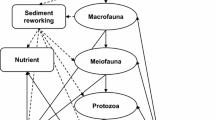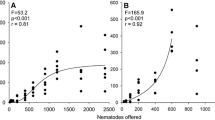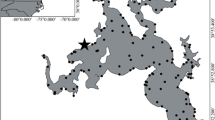Abstract
The aim of this study was to enhance current knowledge of thus far largely neglected meiofaunal–macrofaunal trophic channels in freshwater ecosystems. The strength and shape (functional response) of the predator–prey interaction between two freshwater triclad flatworm species (Polycelis tenuis and Planaria torva) and individuals of the nematode species Caenorhabditis elegans were measured in a set of laboratory experiments. We hypothesized that feeding on adult nematodes results in a hyperbolic type II, whereas juvenile prey led to sigmoidal type III functional response and that different habitat textures would affect predation success by providing refuge for prey. However, our results revealed that both flatworm species exhibited type III sigmoidal functional response curves and the smallest predator consistently ingested larger amounts of nematodes. Generally, our results suggest the existence of a strong predator–prey interaction, given that both flatworms daily ingested a significant proportion of their biomass by feeding only on nematodes (up to 30% for P. tenuis). However, P. torva was unable to process nematodes in sandy sediment, and the ingestion rates of both flatworm species were reduced in a complex litter habitat.

Similar content being viewed by others
References
Alexander, M. E., J. T. A. Dick & N. E. O’Connor, 2013. Trait-mediated indirect interactions in a marine intertidal system as quantified by functional responses. Oikos 122: 1521–1531.
Andrássy, I., 1956. Die Rauminhalts- und Gewichtsbestimmung der Fadenwuermer (Nematoda). Acta Zoologica Budapest 2: 1–15.
Armitage, M. J. & J. O. Young, 1990. The realized food niches of three species of stream-dwelling triclads (Turbellaria). Freshwater Biology 24: 93–100.
Ball, I. R. & T. B. Reynoldson, 1981. British Planarians. Cambridge University Press, Cambridge.
Barrios-O’Neill, D., J. T. A. Dick, M. C. Emmerson, A. Ricciardi & H. J. MacIsaac, 2015. Predator-free space, functional responses and biological invasions. Functional Ecology 29: 377–384.
Barrios-O’Neill, D., R. Kelly, J. T. A. Dick, A. Ricciardi, H. J. MacIsaac & M. C. Emmerson, 2016. On the context-dependent scaling of consumer feeding rates. Ecology Letters 19: 668–678.
Begon, M., J. L. Harper & C. R. Townsend, 1996. Ecology: individuals, populations, and communities. Blackwell, Oxford.
Beier, S. & W. Traunspurger, 2003a. Temporal dynamics of meiofauna communities in two small submountain carbonate streams with different grain size. Hydrobiologia 498: 107–131.
Beier, S. & W. Traunspurger, 2003b. Seasonal distribution of freeliving nematodes in the Krähenbach, a fine- grained submountain carbonate stream in Southwest Germany. Nematology 5: 113–136.
Beier, S., M. Bolley & W. Traunspurger, 2004. Predator-prey interactions between Dugesia gonocephala and free-living nematodes. Freshwater Biology 49: 77–86.
Benke, A. C., A. D. Huryn, L. A. Smock & B. Wallace, 1999. Length-mass relationships for freshwater macroinvertebrates in North America with particular reference to the southeastern United States. Journal of the North American Benthological Society 18: 308–343.
Bergtold, M. & W. Traunspurger, 2005. Benthic production by micro-, meio-, and macrobenthos in the profundal zone of an oligotrophic lake. Journal of the North American Benthological Society 24: 321–329.
Bolker, B. M., 2014. bbmle: tools for general maximum likelihood estimation. R Package version 1.0.17. http://cran.r-project.org/package=bbmle.
Feller, R. J. & R. M. Warwick, 1988. Energetics. In Higgins, R. P. & H. Thiel (eds), Introduction to the study of meiofauna. Smithsonian Institution Press, Washington: 181–196.
Findeis, P. M., C. J. Barinaga, J. D. Willet & S. O. Farwell, 1983. Age-synchronous culture of Caenorhabditis elegans: technique and applications. Experimental Gerontology 18: 263–275.
Folsom, T. C. & H. F. Clifford, 1978. The population biology of Dugesia tigrina (Platyhelminthes: Turbellaria) in a thermally enriched Alberta, Canada Lake. Ecology 59: 966–975.
Hakenkamp, C. C., A. Morin & D. L. Strayer, 2002. The functional importance of freshwater meiofauna. In Rundle, S. D., A. L. Robertson & J. M. Schmid-Araya (eds), Freshwater Meiofauna: Biology and Ecology. Backhuys, Leiden: 321–335.
Hassell, M. P., 1978. The dynamics of arthropod predator- prey systems. Princeton University Press, Princeton.
Hassell, M. P., J. H. Lawton & J. R. Beddington, 1976. The components of arthropod predation: I. The prey death-rate. Journal of Animal Ecology 45: 135–164.
Hassell, M. P., 2000. The Spatial and Temporal Dynamics of Host-Parasitoid Interactions. Oxford University Press, London.
Hildrew, A. G., 1992. Food webs and species interactions. In Calow, P. & G. E. Petts (eds), The Rivers Handbook. Blackwell Scientific Publications, Oxford: 309–330.
Hohberg, K. & W. Traunspurger, 2005. Predator-prey interactions in soil food web: functional response, size-dependent foraging efficiency, and the influence of soil texture. Biology and Fertility of Soils 41: 419–427.
Holling, C. S., 1959. The components of predation as revealed by a study of small mammal predation of the European pine sawfly. The Canadian Entomologist 91: 293–320.
Humphries, A. T., M. K. La Peyre & G. A. Decossas, 2011. The effect of structural complexity, prey density, and “predator- free space” on prey survivorship at created oyster reef mesocosms. PLoS ONE 6: e28339.
Jennings, J. B., 1957. Studies on feeding, digestion, and food storage in free-living flatworms (Platyhelminthes: Turbellaria). Biological Bulletin 112: 63–80.
Jeschke, J. M., M. Kopp & R. Tollrian, 2002. Predator functional responses: discriminating between handling and digesting prey. Ecological Monographs 72: 95–112.
Jeschke, J. M., M. Kopp & R. Tollrian, 2004. Consumer-food systems: why type I functional responses are exclusive to filter feeders. Biological Reviews 79: 337–349.
Juliano, S. A., 2001. Nonlinear curve fitting. In Scheiner, S. M. & J. Gurevitch (eds), Design and Analysis of Ecological Experiments, 2nd ed. Oxford University Press, Oxford: 178–196.
Kalinkat, G., U. Brose & B. C. Rall, 2013a. Habitat structure alters top-down control in litter communities. Oecologia 172: 877–887.
Kalinkat, G., F. D. Schneider, C. Digel, C. Guill, B. C. Rall & U. Brose, 2013b. Body masses, functional responses and predator-prey stability. Ecology Letters 16: 1126–1134.
Majdi, N. & W. Traunspurger, 2015. Free-living nematodes in the freshwater food web: a review. Journal of Nematology 47: 28–44.
Majdi, N., M. Tackx & E. Buffan- Dubau, 2012. Trophic positioning and microphytobenthic carbon uptake of biofil- dwelling meiofauna in a temperate river. Freshwater Biology 57: 1180–1190.
Majdi, N., A. Boiché, W. Traunspurger & A. Lecerf, 2014. Predator effects on a detritus-based food web are primarily mediated by non-trophic interactions. Journal of Animal Ecology 83: 953–962.
Majdi, N., B. Kreuzinger-Janik & W. Traunspurger, 2016. Effects of flatworm predators on sediment communities and ecosystem functions: a microcosm approach. Hydrobiologia 776: 193–207.
Majdi, N., I. Threis & W. Traunspurger, 2017. It’s the little things that count: meiofaunal density and production in the sediment of two headwater streams. Limnology and Oceanography 62: 151–163.
Marinelli, R. L. & B. C. Coull, 1987. Structural complexity and juvenile fish predation on meiobenthos: an experimental approach. Journal of Experimental Marine Biology and Ecology 108: 67–81.
Mathieu, M., J. Leflaive, L. Ten- Hage, R. de Wit & E. Buffan-Dubau, 2007. Free-living nematodes affect oxygen turnover of artificial diatom biofilms. Aquatic Microbial Ecology 49: 281–291.
Mckee, M., F. Wrona, G. Scrimgeour & J. Culp, 1997. Importance of consumptive and non-consumptive prey mortality in a coupled predator-prey system. Freshwater Biology 38: 193–201.
Montoya, J. M., S. L. Pimm & R. V. Solé, 2006. Ecological networks and their fragility. Nature 442: 259–264.
Murdoch, W. W. & R. J. Marks, 1973. Predation by coccinellid beetles: experiments on switching. Ecology 54: 160–167.
Murdoch, W. W., S. Avery & M. E. B. Smyth, 1975. Switching in predatory fish. Ecology 56: 1094–1105.
Muschiol, D., M. Marković, I. Threis & W. Traunspurger, 2008. Predator-prey relationship between the cyclopoid copepod Diacyclops bicuspidatus and a free-living bacterivorous nematode. Nematology 10: 55–62.
Oaten, A. & W. W. Murdoch, 1975. Predator switching, functional response, and stability. American Naturalist 109: 299–318.
Pickavance, J. R., 1971a. The diet of the immigrant Planarian Dugesia tigrina (Girard): I. Feeding in the Laboratory. Journal of Animal Ecology 40: 623–635.
Pickavance, J. R., 1971b. The diet of the immigrant Planarian Dugesia tigrina (Girard): II. Food in the wild and comparison with some british species. Journal of Animal Ecology 40: 637–650.
Pritchard, D. W., 2014. frair: functional response analysis in R. R Package version 0.4. http://cran.r-project.org/package=frair.
Pritchard, D. W., R. A. Paterson, H. C. Bovy & D. Barrios-O´Neill, 2017. Frair: an R package for fitting and comparing consumer functional responses. Methods in Ecology and Evolution 8: 1528–1534.
Ptatscheck, C., B. Kreuzinger-Janik, H. Putzki & W. Traunspurger, 2015. Insights into the importance of nematode prey for chironomid larvae. Hydrobiologia 757: 143–153.
Rall, B. C., C. Guill & U. Brose, 2008. Food-web connectance and predator interference dampen the paradox of enrichment. Oikos 117: 202–213.
R Development Core Team, 2017. R: a language and environment for statistical computing. R Foundation for Statistical Computing, Vienna.
Real, L. A., 1977. The kinetics of functional response. The American Naturalist 111: 289–300.
Reiss, J. & J. M. Schmid-Araya, 2010. Life history allometries and production of small fauna. Ecology 91: 497–507.
Reynoldson, T. B., 1960. A quantitative study of the population biology of Polycelis tenuis (Ijima) (Turbellaria, Tricladida). Oikos 11: 125–141.
Reynoldson, T. B. & P. Bellamy, 1975. Triclads (Turbellaria: Tricladida) as predators of lake-dwelling stonefly and mayfly nymphs. Freshwater Biology 5: 305–312.
Reynoldson, T. B. & R. W. Davies, 1970. Food niche and coexistence in lake-dwelling triclads. Journal of Animal Ecology 39: 599–617.
Reynoldson, T. B. & B. Pearce, 1979. Predation on snails by three species of triclad and its bearing on the distribution of Planaria torva. Journal of Zoology 189: 459–484.
Reynoldson, T. B. & A. D. Sefton, 1976. The food of Planaria torva (MÜLLER) (Turbellaria-Tricladida), a laboratory and field study. Freshwater Biology 6: 383–393.
Reynoldson, T. B. & J. O. Young, 1963. The food of four species of lake-dwelling triclads. Journal of Animal Ecology 32: 175–191.
Rogers, D., 1972. Random search and insect population models. Journal of Animal Ecology 41: 369–383.
Sarnelle, O. & A. E. Wilson, 2008. Type III functional response in Daphnia. Ecology 89: 1723–1732.
Sarnelle, O., J. D. White, T. E. Geelhoed & C. L. Kozel, 2015. Type III functional response in the zebra mussel, Dreissena polymorpha. Canadian Journal of Fisheries and Aquatic Sciences 72: 1202–1207.
Schmid-Araya, J. M. & P. E. Schmid, 2000. Trophic relationships: integrating meiofauna into a realistic benthic food web. Freshwater Biology 44: 149–163.
Schmid-Araya, J. M., A. G. Hildrew, A. Robertson, P. E. Schmid & J. Winterbottom, 2002a. The importance of meiofauna in food webs: evidence from an acid stream. Ecology 83: 1271–1285.
Schmid-Araya, J. M., P. E. Schmid, A. Robertson, J. Winterbottom, C. Gjerløv & A. G. Hildrew, 2002b. Connectance in stream food webs. Journal of Animal Ecology 71: 1056–1062.
Schmid-Araya, J. M., P. E. Schmid, S. P. Tod & G. F. Esteban, 2016. Trophic positioning of meiofauna revealed by stable isotopes and food web analyses. Ecology 97: 3099–3109.
Schroeder, F., L. Peters & W. Traunspurger, 2012. Temporal variations in epilithic nematode assemblages in lakes of different productivities. Fundamental Applied Limnology 181: 143–157.
Solomon, M. E., 1949. The natural control of animal populations. Journal of Animal Ecology 18: 1–35.
Spieth, H. R., T. Möller, C. Ptatscheck, A. Kazemi-Dinan & W. Traunspurger, 2011. Meiobenthos provides a food resource for young cyprinids. Journal of Fish Biology 78: 138–149.
Sulston, J. & J. Hodgkin, 1988. Methods. In Wood, W. B. (ed.), The nematode Caenorhabditis elegans. Cold Spring Harbor Laboratory Press, Plainview: 587–606.
Teal, J. M., 1957. Community metabolism in a temperate cold spring. Ecological Monographs 27: 283–302.
Toscano, B. J. & B. D. Griffen, 2013. Predator size interacts with habitat structure to determine the allometric scaling of the functional response. Oikos 122: 454–462.
Traunspurger, W., 1996a. Distribution of benthic nematodes in the littoral of an oligotrophic lake (Königssee, Nationalpark Berchtesgaden, FRG). Archiv für Hydrobiologie 135: 393–412.
Traunspurger, W., 1996b. Distribution of benthic nematodes in the littoriprofundal and profundal of an oligotrophic lake (Königssee, Nationalpark Berchtesgaden, FRG). Archiv für Hydrobiologie 135: 555–575.
Traunspurger, W., M. Bergtold & W. Goedkoop, 1997. The effects of nematodes on bacterial activity and abundance in a freshwater sediment. Oecologia 112: 118–122.
Traunspurger, W., S. Höss, A. Witthöft-Mühlmann, M. Wessels & H. Güde, 2012. Meiobenthic community patterns of oligotrophic and deep Lake Constance in relation to water depth and nutrients. Fundamental Applied Limnology 180: 233–248.
Vucic-Pestic, O., B. C. Rall, G. Kalinkat & U. Brose, 2010. Allometric functional response model: body masses constrain interaction strengths. Journal of Animal Ecology 79: 249–256.
Ward, J. V., G. Bretschko, M. Brunke, D. Danielopol, J. Gilbert, T. Gonser & A. G. Hildrew, 1998. The boundaries of river systems: the metazoan perspective. Freshwater Biology 40: 531–569.
Weber, S. & W. Traunspurger, 2015. The effects of predation by juvenile fish on the meiobenthic community structure in a natural pond. Freshwater Biology 60: 2392–2409.
Acknowledgements
We are grateful to Stefanie Gehner for technical assistance and to Birgit Gansfort and Benjamin Wilden for their help with the statistics.
Author information
Authors and Affiliations
Corresponding author
Additional information
Handling editor: Diego Fontaneto
Electronic supplementary material
Below is the link to the electronic supplementary material.
Rights and permissions
About this article
Cite this article
Kreuzinger-Janik, B., Kruscha, S., Majdi, N. et al. Flatworms like it round: nematode consumption by Planaria torva (Müller 1774) and Polycelis tenuis (Ijima 1884). Hydrobiologia 819, 231–242 (2018). https://doi.org/10.1007/s10750-018-3642-8
Received:
Revised:
Accepted:
Published:
Issue Date:
DOI: https://doi.org/10.1007/s10750-018-3642-8




